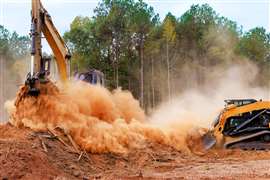Electric & hybrid power in access
04 June 2019
Anyone who visited Bauma in April will have noted that electric and hybrid-powered equipment was the talk of the showground.
By and large, in the access realm, there is also a significant move towards Lithium-ion batteries, in particular. Although Lithium has its drawbacks in that it is still relatively expensive and the recycling of used units is problematic, it has many advantages over lead acid batteries when it comes to day-to-day use. That includes the fact they should last the lifetime of a machine and require little maintenance, with the inclusion of a decent battery management system.
Electric power is not new to access equipment, of course. Slab scissors and tracked platforms are two longstanding examples, both of which are adopting Lithium too in greater numbers. It’s the move to electric and hybrid rough terrain booms, and scissors, that is piquing the interest of the modern access industry.
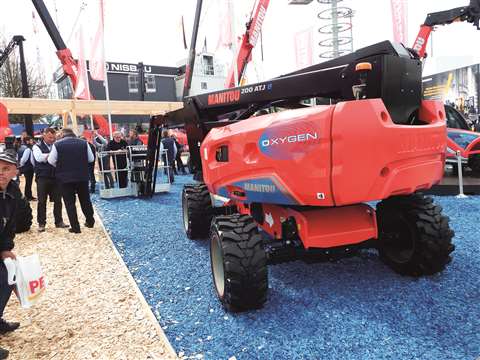
It’s not all about Lithium, however. Manitou launched its electric and hybrid range at Bauma. The Oxygen line includes a new aerial platform and two telehandler models.
The ATJ 200 e Oxygen is the group’s first electric all terrain aerial platform and is powered by lead acid batteries. With a working height of up to 20m for a maximum capacity of 230kg, the model provides the same performance as a diesel-powered version, says the company.
Francois Desbriere, head of aerial platform segment at Manitou, said it had taken nearly two years to develop the new technology in line with the company’s existing products. The ATJ 200 e uses the company’s existing axle, with a new AC motor inside the chassis that powers all wheels in constant four-wheel drive mode, and two-wheel steer. This is in contrast to competing models that use motors on each axle.
There are two 24 volt battery packs, meaning it does not rise above the 70 volt threshold, allowing technicians to work on it without special certification. It can achieve up to one working day on full charge, even in adverse weather conditions. Manitou chose lead acid over Lithium as the former is well-established in the market. “There is no space issue with this option, and rental companies know and understand it, and it is cheaper then Lithium-ion. Also, 95% of the battery can be recycled,” says Desbriere.
The full electric machine will be available by the end of 2019 and a hybrid version will be in production in 2020. And the plan is to extend the range. Desbriere says the machine had drawn a lot of attention, particularly from customers based in northern European countries, like Germany, Sweden and Norway. “I am still convinced that hybrid is the short- to mid-term solution. But, ultimately, construction sites will have the ability to change their methods and electric will become more popular.”
The company also launched the MRT 2550 h Oxygen Lab telehandler; a hybrid prototype version of the diesel MRT 2550 model, capable of operating in 100% electric mode. Retaining the same characteristics as the diesel-powered version, it has 25 m lifting height for a capacity of 5 tonnes.
Electric telehandler
Another launch from Manitou, still very much in concept stage, is the MT 625 e Oxygen. It is a lightweight telehandler designed to be completely electric, this time with Lithium batteries. Although, the concept does at the moment have a small diesel engine to assist travel, this will be changed to a battery version in the future.
Haulotte notably made a promise at Intermat last year that all its new models of booms would be electric-powered. The new Pulseo generation of booms does offer a combustion engine to recharge the battery in exceptional circumstances when the battery runs down but is essentially designed to be electrically-powered. The manufacturer is looking to expand its electric offering outside of the European core markets, and last year opened new locations in Beijing and Guangzhou and plans an office in Wuhan in 2019, to add to its existing Shanghai head office and manufacturing plant in Changzhou.
Harry Wang, Haulotte’s general manager for China acknowledged being uncertain about the reception in China of the all-electric booms but said the recent launch event in Guangzhou with 120 Chinese customers had been a success. “After the launch we received fantastic feedback from the market. Chinese people want better air quality. The Pulseo product is aligned with the demands of Chinese people.”
As previously announced in the March issue of AI, JLG has taken a different tack with its new all-electric AJ boom range, available in three models – 340AJ, 450AJ and 520AJ – offering working heights from 12m to 18m.
Matching performance
The range is equipped with Lithium batteries and 2-wheel drive as standard. Barrie Lindsay, director of engineering in Leicester, UK, says, “As a manufacturer we have improved access to alternative drive systems now that the availability of electric drive technology has matured. At this point in time we are ready to match technology with application.
“Also, battery development has improved throughout the years and faster and opportune charging is a reality. For JLG it is imperative there should be no performance reduction in uptime, duty cycles or terrain ability.” See more information about the range in the Articulating booms feature in the March issue of AI.

At Bauma, it was also announced that Dana and JLG had partnered as part of JLG’s electrification initiative. The Spicer Electrified e-Axle has a combination of electrified drive components that reduces power losses by up to 20%, compared with traditional diesel-powered drivetrains.
It includes a range of Dana’s brands, including Spicer axle components and drive and motion intelligence, SME motor and control technologies and gearing that can be fine-tuned depending on vehicle size and performance. Together, the components improve the efficiency of the drive system, which allows the use of downsized battery systems. The company says noise and vibration is also improved, as are working hours and operating range.
The system also incorporates the Spicer Smart Suite Intelligent Load Monitoring System (ILMS) and intelligent steering. And in line with telematics requirements of modern machinery, it has a patented data-collecting system to prevent tip-overs, provide calibration management and estimate axle attitude. The steer system continuously analyses vehicle operation to adjust steering angles.

Snorkel also showed a preview of its first-ever Lithium-ion powered lift at Bauma, in the form of a new zero-emission Speed Level. The SL26E has a 17kWh Hyperdrive Lithium battery pack with an integrated battery management system (BMS), and delivers extended duty cycles for longer, continuous operation on the jobsite, says the company. The manufacturer also launched a new generation of electric slab scissor lifts. The first being the S3019E, with both electric drive and electric steer, meaning no hydraulic hoses.
Indeed, all manufacturers are seeing the benefits of Lithium, including the Chinese manufacturers. For example, Sinoboom is moving towards a greater range of electric equipment too. The company says it will offer a Lithium option across its whole range of slab scissors. Next up will be a rough terrain scissor, says the company, with electric drive powered by Lithium or lead acid batteries as options.
There is no doubt that electric-propelled access equipment represents the future. However, while we are heading in that direction, and as concept equipment is under development, rental companies require rough terrain booms that can be used right now.
Genie’s growing hybrid line is designed to do just that. Visitors to Bauma saw the second instalment of the FE range, represented by the 15.92m working height articulating Z-45 FE hybrid.
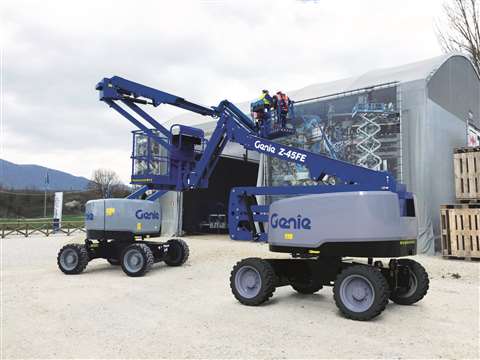
Designed using the same technology as its bigger sister, the Z-60 FE, formerly known as Z-60/37 FE, the new Genie Z-45 FE has a maximum outreach of 6.94m, a maximum up-and-over reach of 7.5m and 300kg lift capacity. The Z-45 FE boom lift is designed to combine the performance of typical 4WD diesel machines with the benefits of 100% electric powered units and has an active oscillating axle. In all-electric mode, it provides the ability to work a full shift on a single battery charge. In hybrid mode, it offers more than a week of run time on a single tank of diesel.
In hybrid mode, the Z-45 FE boom lift uses a Stage V/Tier 5 engine-powered generator to maintain battery charge. It also uses braking energy to recharge its batteries.
Requiring 30% less fuel than typical 36.5 kW (49 hp) diesel machines, it also offers the advantage of saving €25 Euros ($28) of fuel a week and the ability to run for a full shift on an overnight battery charge, says the company.
Truck mounts
Truck mounts are also increasingly moving into the world of hybrid and indeed complete electric. Ruthmann was showing the first hybrid in its premium brand Steiger range at Bauma, the TB 270 Hybrid.
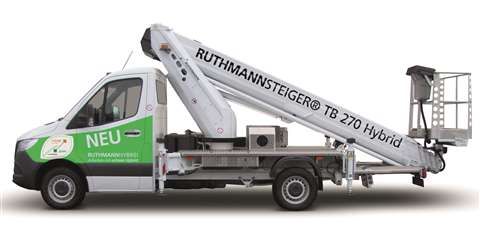
Coupled with the company’s first fully-electric compact Steiger, the Ampero TBR 250 E, it says it is responding to the growing demand for truck mounts with alternative, emission-free drive types. Almost silent and CO2-free the 27m working height TB 270 Hybrid can carry out work in inner cities, pedestrian zones or residential areas outside of the usual time restrictions, those being early in the morning or evening, and without disturbing passers-by and local residents.
A Lithium battery is installed alongside the chassis combustion engine. Optionally, there is an automatic switchover between the battery and the combustion engine, without any loss in performance or speed while in the battery mode. To compensate for the weight of the battery pack, the TB 270 Hybrid is installed on a 3.5 tonne Mercedes Sprinter chassis with GRP-RA suspension - leaf springs made of glass fibre reinforced plastic - and a 45 litre tank. In addition, the passenger seat has been removed. Should the customer require a chassis with a greater vehicle load capacity or a passenger seat, it is possible to use the 5 tonne class Mercedes Sprinter chassis.
The TB 270 Hybrid can also match performance levels of its traditionally-powered sister model the TB 270 with an outreach of 16.4m and a basket capacity of 230kg. The new model now joins the Ecoline 160 and 180 Hybrid models from the manufacturer’s lower cost range.
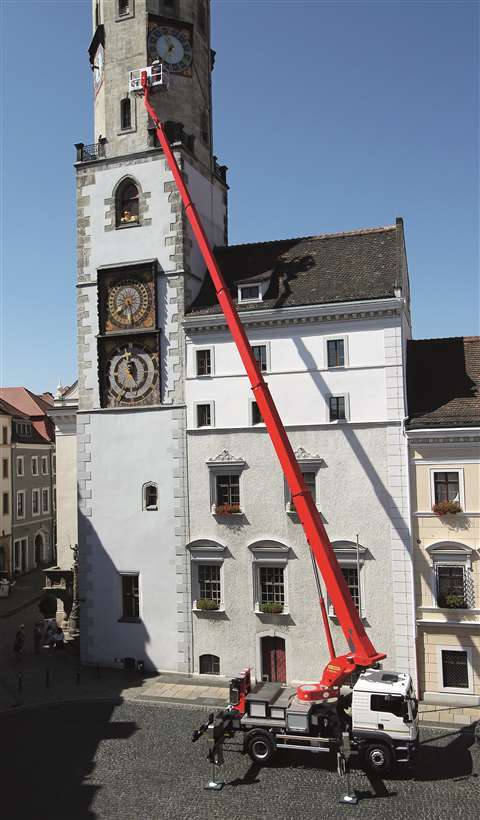
Last year Palfinger presented its first electrically-operated access platform. The 37m working height P 370 KS E is driven on a standard truck but it combines a diesel drive system with an electric drive, which means it is designed to offer the performance and service life of a diesel engine at lower operating costs.
Compared with an all-diesel machine, it offers fuel savings and emits less than 62decibels, and has lower CO2 emissions. An intelligent quick-charging function means the 40 KVA wet cell battery can be charged in around six hours, which the company says is 25% less than normal.
Depending on how the product is used the P 370 KS E can be operated for one full working day. An external power supply provides on-site charging during downtimes and breaks. The intelligent charging system with an integrated quick-charging function means that one hour of charging, can provide up to one and a half hours of electric operation. With a maximum cage load of 500kg, it can achieve lateral outreach of 31.5m. However, it still remains compact with a vehicle length of 8.35m and the patented counter slewing device.
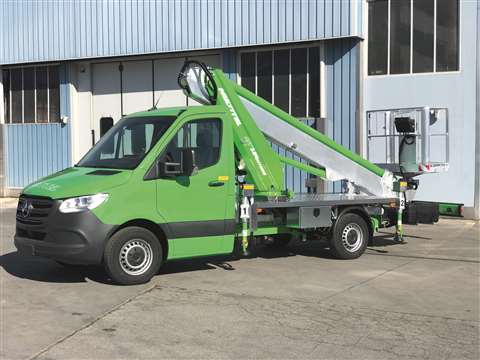
Following Multitel Pagliero’s previous 160 Alu Hybrid and MT162 Hybrid launches, it has extended its range with the new MT204 Hybrid. The platform is powered by an on-board battery pack and is based on the Multitel MT162 Hybrid and in this case, the new 20m offers a great performance, with 20.4m of working height and 12m outreach. It has a 200kg cage load and 9.9m outreach, with 300kg cage load. It is mounted on a standard MB Sprinter or Iveco Daily 35 S 13 and stays below the 3500kg weight limit even with fuel and driver.
The MT204H uses a conventional engine to travel, while a second alternator on the vehicle engine recharges the battery pack. When on the work site the platform can be deployed on its outriggers using either the vehicle PTO or the on-board batteries. Thereafter the platform will give a full day’s work powered by the on-board lithium batteries. The batteries power a variable speed electric motor which in turn powers a hydraulic pump to drive the platform.
Utility focus
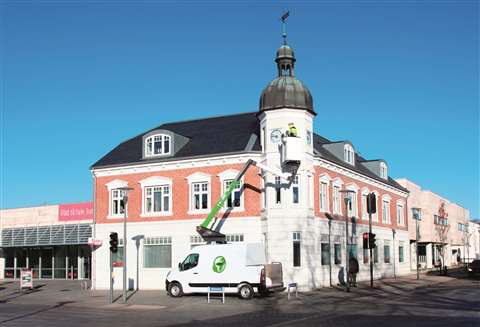
Of course, an area of real potential for 100% electric equipment lies in utility platforms mounted on small vehicles, such a van mounts. Manufacturers of this product type have been expanding their electric ranges for a couple of year now. And at Bauma Versalift showed its 100% electric vehicle lift, incorporating its existing VTL-120 platform mounted on a fully-electric Renault Master van. It has a working height of 11.7m and a basket capacity of 120kg. The vehicle has a range of 100km loaded to its maximum capacity. The unit also has a payload of 185kg, including driver and passenger.
The 100% electric lift is powered by a Lithium-ion battery and is available with either a small, 2.5 kW or big, 5 kW, power pack. The small battery can perform 20-30 cycles, while the larger can provide 40-60 cycles. Versalift can also offer 100% electric lifts with its VDTL-38-140 or VTL-37-135 platforms mounted on the Renault Master.

France Elevateur has been powering booms with battery packs for years but it too has recently married this option with vans powered by non-conventional method. An example is the 17m working height 172CPL. It uses a 7.2 tonne Eveco van, powered by LPG. It has one-tonne payload and two people in the basket and a 10m outreach, in this configuration.
The company also offers its 121FCCE. This 6.5m working height machine on a cutaway van is fully electric, using the latest generation of Lithium-ion batteries to power it. It can work up to four hours on one charge using the larger battery pack. Anther smaller battery pack is available, offering two hours continuous work.
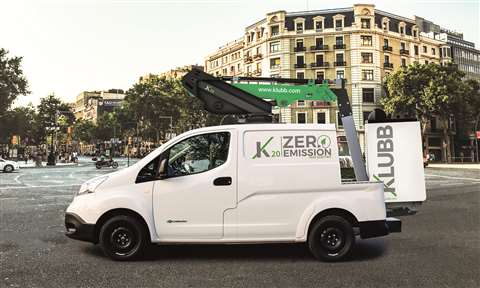
France-based Klubb has had a fully-electric lift, mounted on a cutaway Nissan eNV200 van, for some time. It has a working height of 10m and outreach of 5m, which the company comments is exceptional for its size. “As a European industrialist we are very attentive to clean energies. Our group has obtained the PM UP label, which rewards companies with a proactive approach in this area,” said Julien Bourrellis, president of Klubb.
Engine focus
Perkins was focused on hybrid and electric power at Bauma. Following a significant investment in hybrid engines and electrification research, Perkins was showing a range of technologies designed to add value to OEMs as they design their next generation of equipment.
The engine manufacturer is concentrating no three systems: the hybrid-electric, hybrid-mechanical and hybrid-hydraulic technologies, which complement Perkins existing 0.5–18 litre range of diesel engines.
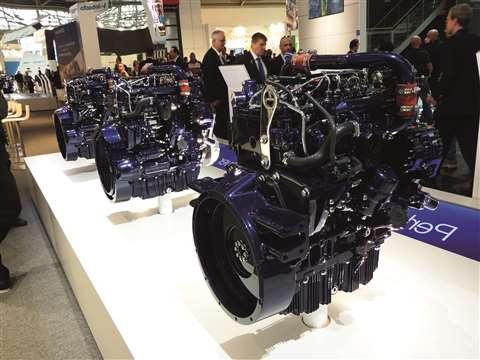
The hybrid and electric options cover the EU Stage V power range from 6 to 470 kW and were represented at Bauma on three engines, all 75 kW and based on the Perkins Syncro 2.8 litre model.
The Hybrid-electric option is suited to access equipment. There are several ways to incorporate the electric motor or generator, with Perkins preferred arrangement delivering fuel saving benefits while moderating the installation impact and minimising the cost impact on the machine. The flexibility of the system provides opportunities for further efficiency and functionality improvements in the whole machine through use of 48-volt electrics.
With access to millions of hours of machine operating data, Perkins has identified that the operating cycles of real construction machines varies from one application to another, and as machine size increases. As such the company has set up the Perkins Expanded Offering Product Team.
“There isn’t one solution that fits all machines,” said “Perkins is establishing itself as an integrator with multiple hybrid and electric power technologies.”
Kubota BUEE (Business Unit Engine Europe) featured a prototype of its latest Micro-Hybrid system. Kubota believes equipment manufacturers will progressively become less reliant on any single power source, and that engines themselves will need to further push the boundaries in efficiency.
The Micro-Hybrid system is designed to help manufacturers exploit advances in down-sizingtechnology, while maintaining the machine’s performance and productivity. It does this by delivering an additional electrical power boost of up to 10kW when required. For example, this means a 3-cylinder Micro-Hybrid equipped engine can achieve similar levels of performance as a conventional 4-cylinder engine. So, it works in partnership with the engine, and leads to reduced fuel consumption and lower operational costs, while offering increases in work efficiency and value.
The system is compatible with many of Kubota’s diesel, gasoline, LPG and natural gas engines across the power ranges.


